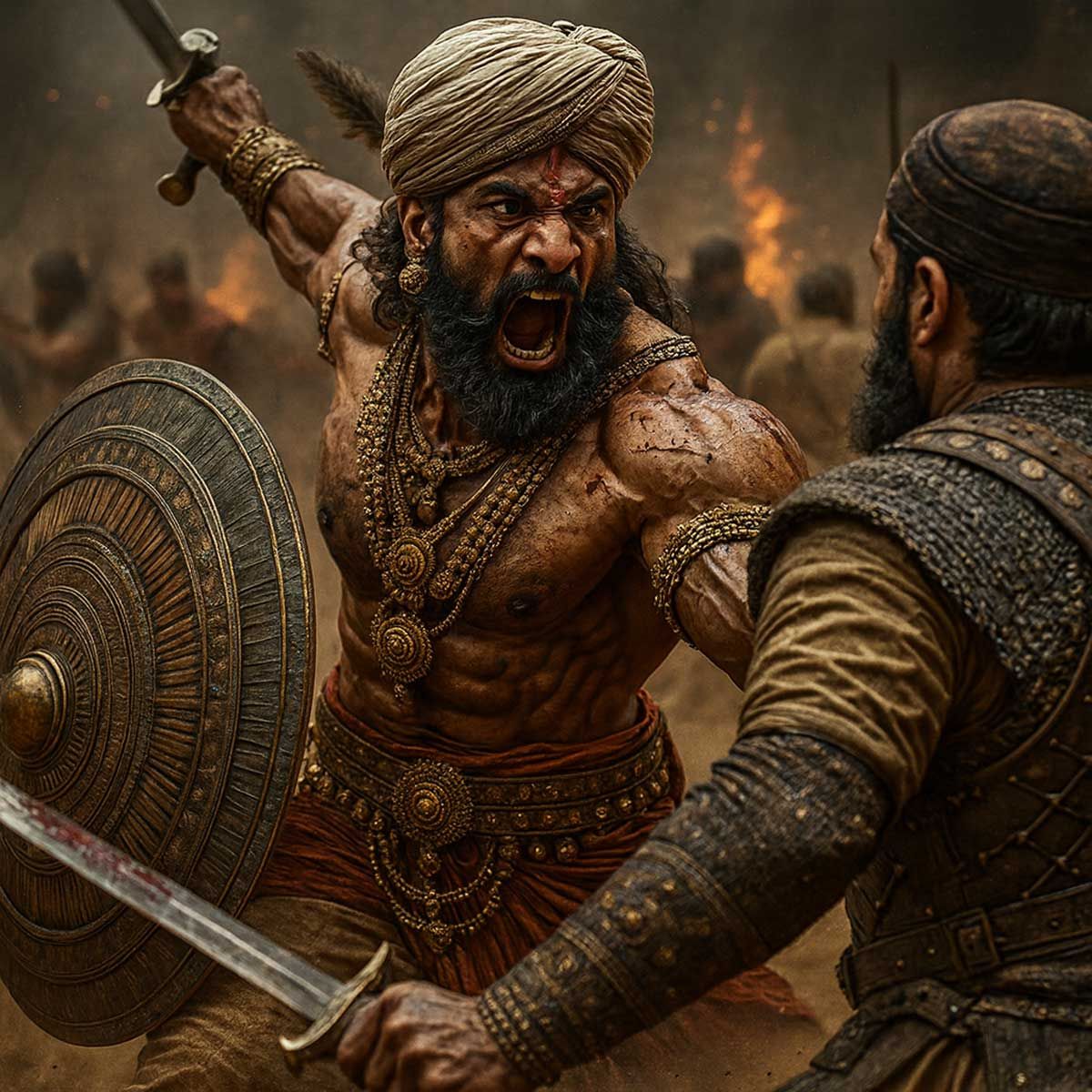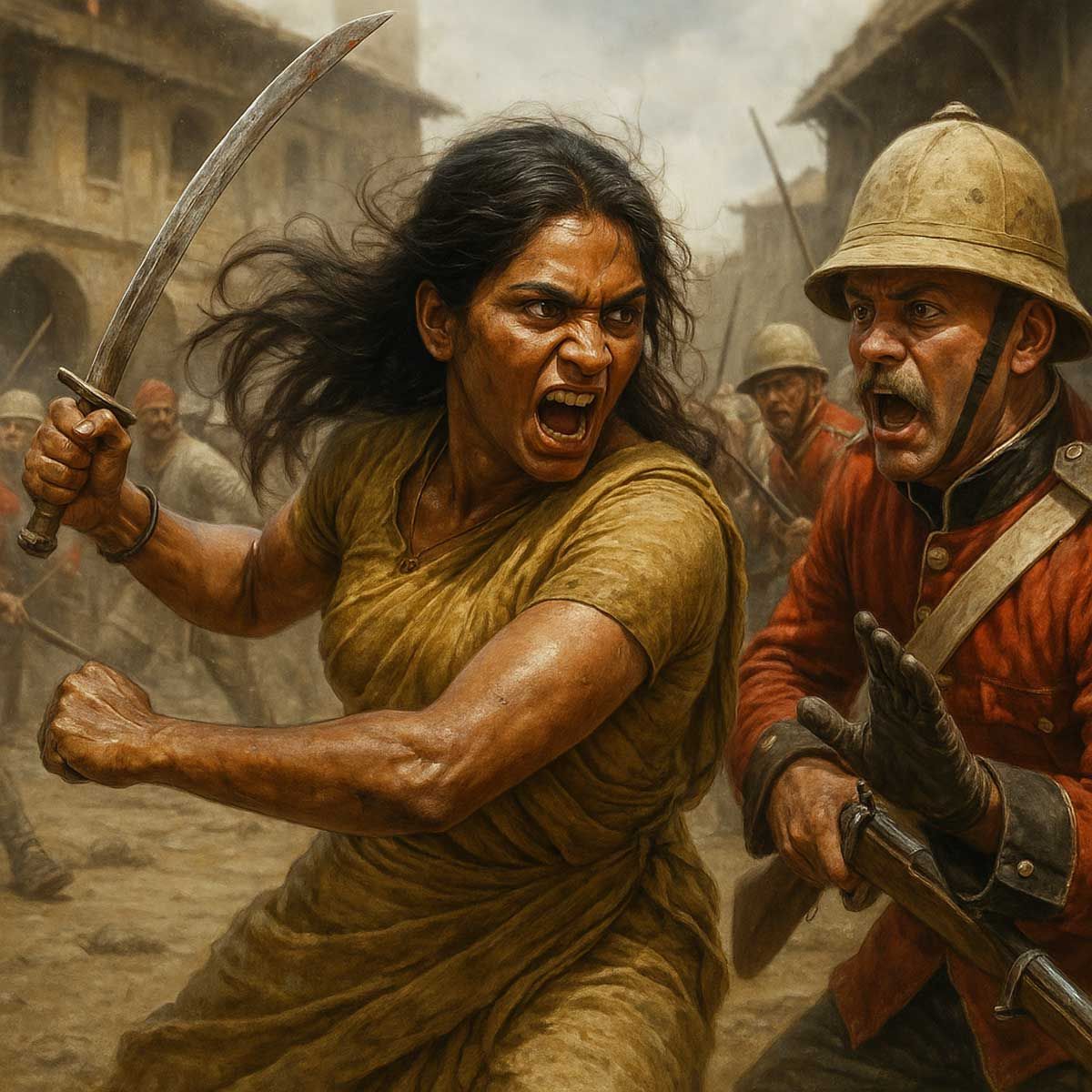More Coverage
Twitter Coverage
Satyaagrah
Written on
Satyaagrah
Written on
Satyaagrah
Written on
Satyaagrah
Written on
Satyaagrah
Written on
Join Satyaagrah Social Media
Khudiram Bose - The symbol of valiance and death-defying youth, an orphan at 7 to hanging by the British at 18
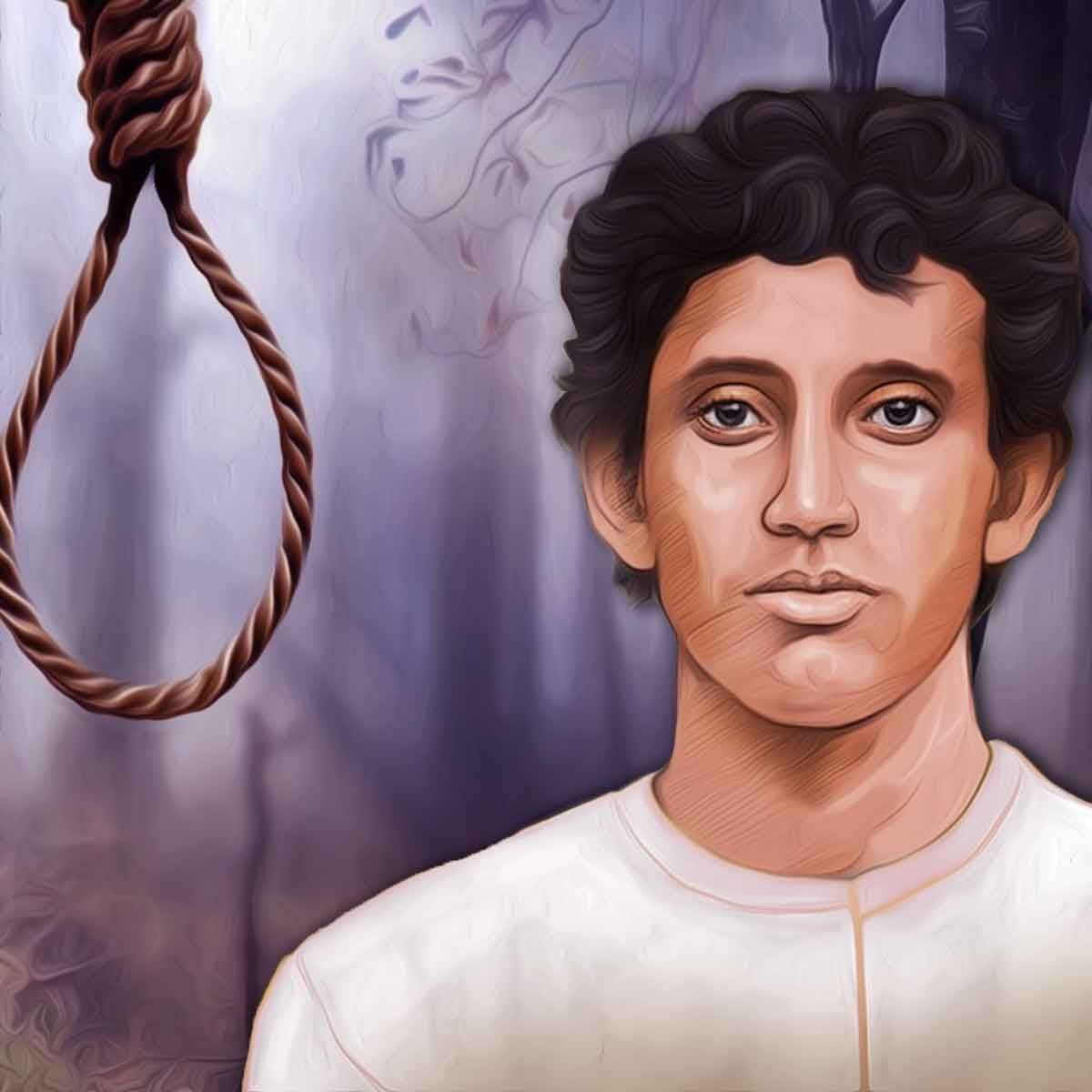
The silent night was approaching dawn. Footsteps of the guards in the jail corridor broke the silence. Slowly it stopped before the ‘condemned cell’. When the get was opened, a teenage boy with a smiling innocent face greeted them.
He advanced in fearless strides to embrace death, with the guards merely following him. He stood upright on the execution platform, with his smile unfazed. His face was covered with green cloth, his hands were tied behind, and the rope encircled his neck. The boy stood unflinching. With the signal of the jailor Mr. Woodman, the hangman pulled the lever. The rope swinging a little became still. It was 6 am. The day was 11th August 1908. The martyrdom of death-defying Khudiram demarcated the onset of a new era in the course of the Indian freedom movement.
The martyrdom of Khudiram rocked the entire nation. The dormant youth of a subject nation, oblivious of its own strength, dignity, and valor shook off its hibernation. Khudiram’s martyrdom brought a new meaning to life, a new concept of dignity to the youth of his day. In his wake, like wave after wave, hundreds and thousands of martyrs upheld the truth that the only way to lead a dignified life is by dedicating it to the noblest cause, freedom. They came one after another, incessantly, shed their blood, faced terrible torture, but never bowed their heads down.
Forgotten Hero
Ekbaar biday de ma ghure ashi
Hashi hashi porbo phashi
dekhbe bharatbashi...
(Mother bid me farewell once, I will be back soon
Whole of India will watch me while I wear the noose smiling….)
Dosh mash dosh din pore
Jonmo nebo mashir ghore Maago
Tokhon jodi na chinte paris
Dekhbi golay phnashi
(10 months and 10 days from now
I shall be born to my maternal aunt O Mother
If you don’t recognize me
Look for the noose around my neck.)
Ekbaar biday de maa ghure ashi
((Mother bid me farewell once, I will be back soon)
This was the song 18-year-old Khudiram sang when he was about to be hanged to death by the British. He was asking his mother (Mother India) to bid him goodbye. This song was composed in the first-person narrative in honor of Khudiram Bose by poet Pitambar Das.
18 years, 8 months, 8 days! This was his age when he was hanged to death by the British. One of the youngest freedom fighters for Maa Bharti from Bengal! Unfortunately, the stories of many of our brave freedom fighters have been wiped away from the pages of our history textbooks.
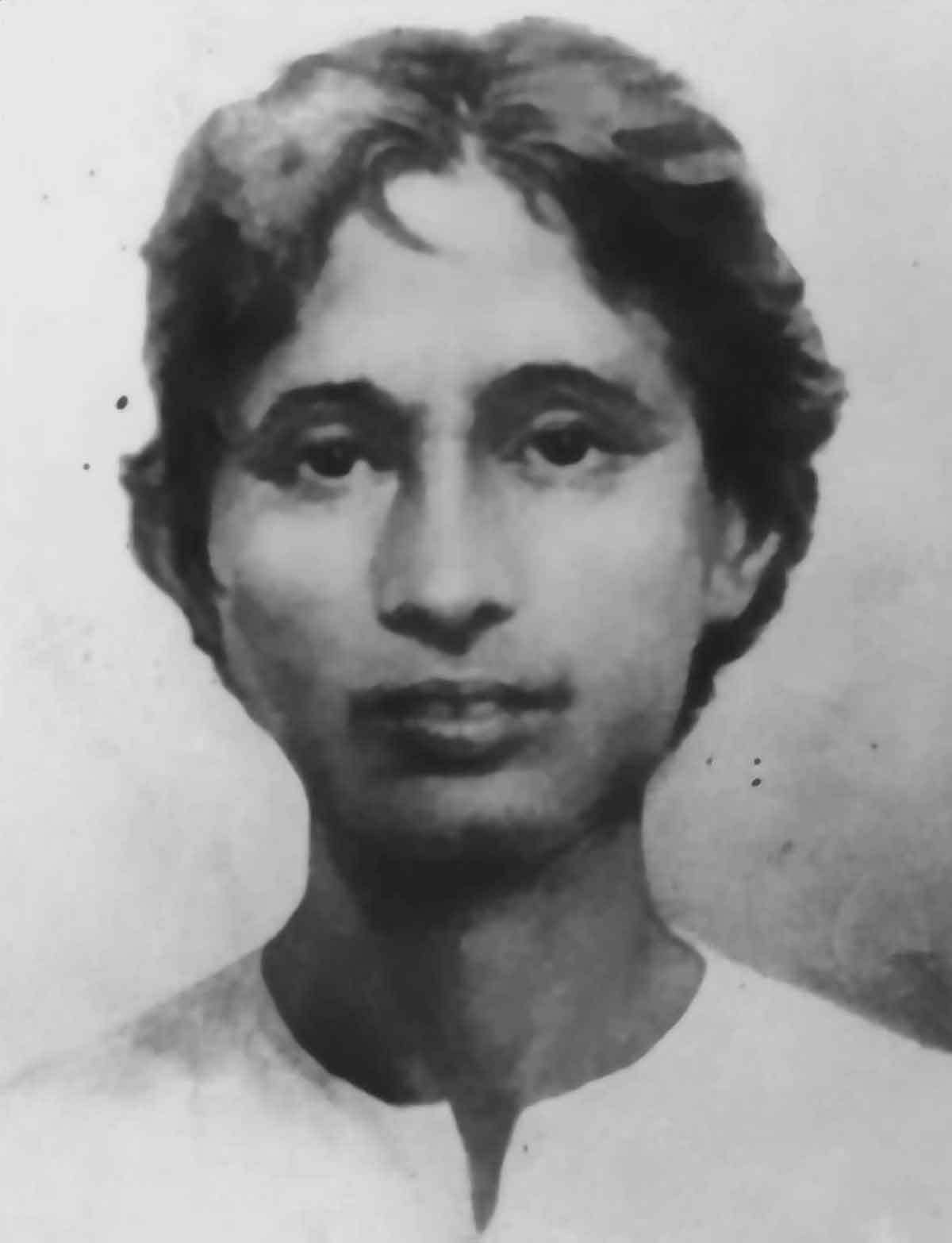 |
Orphan at 6
3rd December 1889. Khudiram was born at Habibpur village, adjacent to Midnapore town. His father was Troilokyanath and his mother was Laksmipriya Devi. He was the youngest member of the family. Aparupa, Sarojini and Nanibala were his three elder sisters. He lost his parents when he was only six years old. So the eldest sister Aparupa Devi took him to her father-in-law’s home at Hatgechha. There at Girish Chandra Mukhopadhyay’s Pathshala (elementary school), his educational life began.
Amritalal Roy was Aparupa’s husband. He was a clerk of the Ghatal Civil Court. When he was transferred to Tamaluk Court, Khudiram also went there with them. In Tamaluk, he was admitted to Hamilton High English School in the fourth class (Standard VII). In his school life, he could be easily distinguished from all the students, due to his bold character and courage. Once in his school, a teacher asked the students to deliver a blow on the table by fist. Twenty boys took part in it, but all of them gave up very soon. Only Khudiram was knocking hard again and again. His fist was bleeding, but he didn’t give up. At last, the teacher hugged him warmly for his determination.
On the other hand, he was very sensitive and soft-hearted. On a winter morning, a beggar came to his home. He was shivering with cold. His worn-out clothes couldn’t provide him the warmth. Khudiram had a shawl. It was a precious possession and the last memento of his departed father. He gave away that shawl to him.
When the beggar left, Aparupa rebuked him, “Why did you give him the shawl? Will he use it? He will immediately sell it.” Khudiram smiled, “I know it very well, didi. But that will help his family for a few days. If it provides a few days' meals, I think that will do justice to my father’s memory.” Again he said, “I can’t control myself when I see that the ill-fed poor men are shivering in cold and the upstart boys of the rich families wrapped in costly apparel pass by them heedlessly smoking cigarettes.” Due to his deep feeling for the poor and destitute people whenever a flood inundated Midnapore he rushed into the rescue work. He used to collect money, rice and clothes and distribute them among the helpless victims.
During his schooldays, the Swadeshi and Bilati Barjan(boycott of foreign goods) movement was going on in Bengal. People supporting the movement wore indigenous clothes. During that time one day, his close friend Phanibhusan Ghosh came to the school wearing a khaddar (indigenous cotton cloth) from the Bombay mill. His other classmates bantered him because it was rough and not as good-looking as the clothes coming from the mills of Manchester, England. But Khudiram strongly supported Phanibhusan by saying, “We should take pride in using all indigenous articles.” His argument moved others. They, all, took an oath that they would never wear foreign clothes.
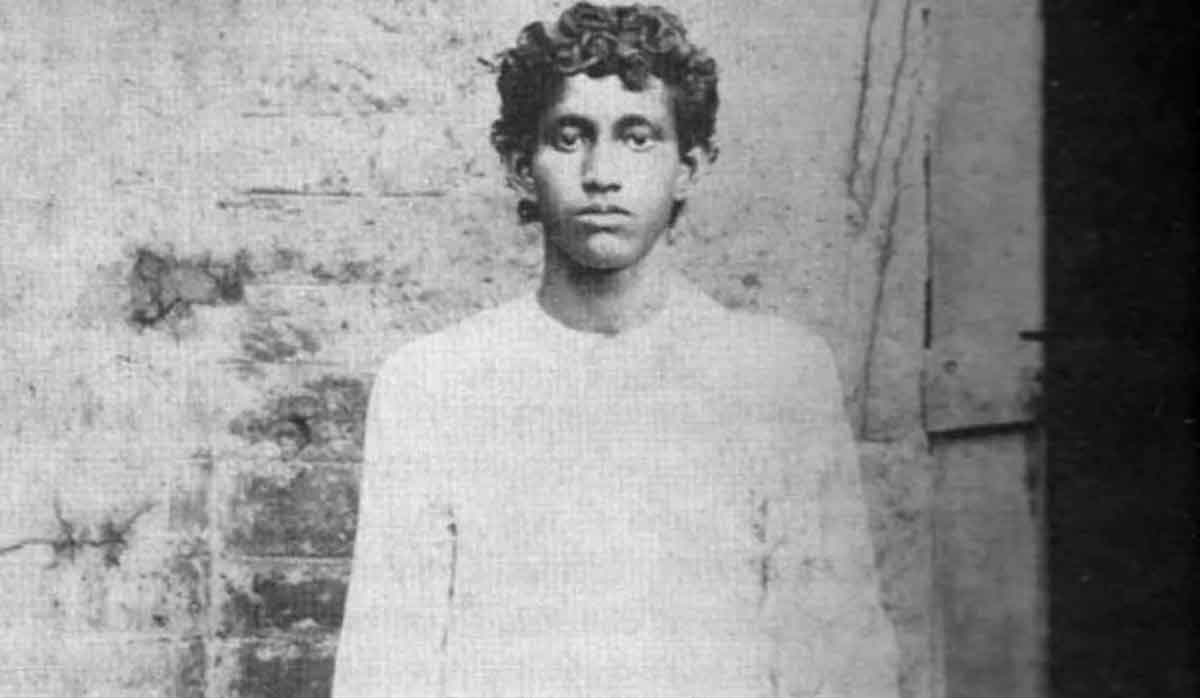 |
Freedom Movement Activities from Age 13
In 1904, when Amritalal again transferred to Midnapore town, Khudiram got admitted to the Midnapore Collegiate School. Here he did not confine himself to study alone. Rather he was involved in a variety of social activities. When an outbreak of cholera turned into an epidemic at Tamluk town, Khudiram rushed there. His relatives asked him not to go there, but he could not be restrained. He nursed the patients and arranged funerals for the victims. This disease is highly contagious, causing an epidemic and at that time was almost incurable, but he didn’t care for his own life. This love and feeling for common people gradually turned into a love for the country and involved him in the freedom movement.
At that time many groups and clubs were being founded in Bengal for physical exercise. These clubs were the centers of physical culture to build up a healthy body, as well as a patriotic mind. The object was to prepare the youth of the country in order to combat the foreign rulers. At Tamaluk Rakshitbati, such a group was formed. It was named ‘Matrisadan’. Khudiram joined this group and soon became its central figure. He was very thin but had a strong and healthy body.
The political environment in Bengal then was becoming turbulent. The British imperialism realized that their existence could be endangered had the resentment of the people turned into an organized protest struggle and the Bengal could be the origin of such outburst. So, in 1905, they brought the blueprint of ‘Partition of Bengal’ on communal lines. But the people strongly refused this proposal. The entire Bengal reverberated, “We don’t accept the partition of Bengal.” Lord Curjeon declared the partition of Bengal as a ‘settled fact’. But the people of Bengal rejected this declaration. Veteran leader Surendranath Bandopadhyay challenged the declaration saying, “We must unsettle the settled fact.”
On 7th August 1905, at a protest meeting held in the Town Hall of Calcutta, the decision of boycotting foreign commodities was taken. On 25th September, a huge number of people gathered at Calcutta Maidan to protest against the ‘Partition’. The police mercilessly lathi-charged the gathering. But that could not frustrate the resentment of the people. It spread throughout Bengal. Foreranking intellectuals of the day, eminent personalities like Rabindranath Tagore, Chittaranjan Das, and Sister Nivedita all joined this movement against the partition of Bengal.
In Midnapore, some secret revolutionary organizations started their activities. Jnanedranath Bose, Satyen Bose, and Hemchandra Kanungo were the pioneers. Satyen Bose was a clerk of the District Collectorate Office (He also later became a martyr on the gallows). Jnanendranath and Hemchandra were schoolteachers. One day Hemchandra was cycling when a young boy blockaded his road and stopped him. From him, the boy demanded a revolver. When Hemchandra asked what would he do with it, the boy told that he wanted to kill a Saheb (i.e., a British exploiter). That very boy was Khudiram. The patriotic feeling gripped him at a very young age.
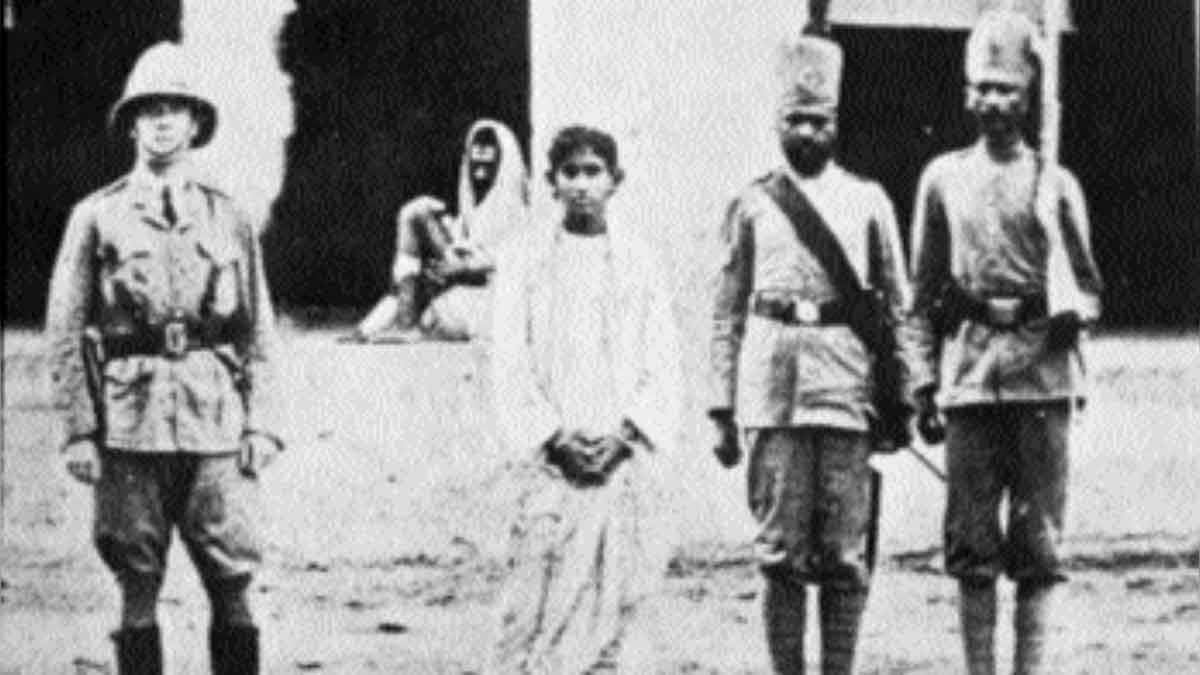 |
One day Khudiram crossed the river Kanshaboti and entered a dense forest. There was a deserted old temple. He was lying there for a long time although there had been many poisonous snakes and dangerous animals around. But he didn’t care. As he was missing for a long time Satyen Bose went out searching for him everywhere. At last, he found him lying on the floor of the temple. In his query, Khudiram told that according to the local belief, if someone did prayer in that temple, any of his diseases would be cured. When Satyen Bose asked what was his disease, Khudiram replied that it was not of him, but of the country, which was suffering from an incurable disease, ‘slavery’. Satyen Bose understood that Khudiram had the mettle for being a true soldier of the freedom movement. He recruited him into their secret revolutionary organization as a volunteer.
Though Khudiram didn’t have any interest in his academic studies, he studied the biography of Mazzini and Garibaldi and other revolutionary books with rapt attention. He considered nothing difficult or impossible for the sake of the freedom movement. When the leaders gave him the responsibility to maintain a regular link with the activities of the organization in Tamaluk and at the same time look after the organizational activities in Midnapore, although Tamluk town was 75 miles away from Midnapore and almost no communication he without any question took up the responsibility and to discharge that he regularly traveled at night alone with a bicycle to go to Tamluk and again return to Midnapore by the morning braving the tremendous hardship and the risk of police arrest.
Khudiram stayed at his elder sister’s husband’s house. His political activities troubled his brother-in-law Amritalal as he was a government servant. He expressed some dissatisfaction over that and advised Khudiram to give up the political activities in order to stay in his house. Khudiram didn’t hesitate a moment to leave the shelter and devote his life to the cause of India’s freedom. At first, he took shelter in a weaver’s workshop at Aliganj, but soon he started to work in the rural areas of Bengal and moved from village to village. He stayed a few days in a cottage of a poor farmer in Bankura. The farmer was old and sick. So, Khudiram helped him in ploughing his land. He never did it before; but when he understood the old man could not till that year, Khudiram readily took up the responsibility of tilling the land although it was very labourious.
The anti-partition movement surged a new tide in Bengal, which crossed its geographical boundary. The boycott and non-cooperation movement were spread throughout the country. The administration failed to control this movement. This wave reached Midnapore also.
In February 1906, an agriculture-industry fair was organized in Midnapore. Satyen Bose and other revolutionary leaders decided to distribute there a pamphlet named Sonar Bangla giving the call for the boycott movement. It was then a highly risky job so Khudiram was deputed for distribution of this pamphlet, as he was a school student. On the last day of the fair, the District Magistrate Mr. D Watson came for prize distribution. Khudiram was at the entrance of the fair. A teacher, Mr. Ramchandra Sen, found that the pamphlet was anti-British, so he forbade him. But Khudiram didn’t pay any heed to his words.
Then Mr. Sen called the police, who caught Khudiram. But he gave a blow to the constable and escaped. Satyen Bose was watching the whole episode from a distance. He tried to misguide the constable by giving him the wrong information about the boy. Although Khudiram escaped the incident did not end then and there. The District Magistrate Mr.Watson summoned Satyen Bose. He dismissed him from his service on 1st April 1906. Khudiram was absconding then. The leaders thought if he surrendered, he would be given light punishment. So they wanted him to surrender. But they had a little inconfidence too that he might divulge secret information regarding the organization under pressure. He was told with exaggeration that the police would torture him in their custody and according to the IPC 121 and 124, he might be given life imprisonment or death sentence.
 Statue of Khudiram Bose in Kolkata |
But it did not frighten him at all. He never uttered a single word about the organization or in his own defense neither in court nor to the police. During his trial, he told his advocate, “Why are you wasting your time and energy to save me? I don’t want to defend myself, nor I’m willing to avoid punishment. If they put me underbar, I’ll be glad. Who is afraid of punishment, imprisonment or death is not befitted to serve the motherland.”
The trial created a stir among the common people, the news spread very quickly that a young boy showed the courage to hit the British police. But in court, the government could not prove its allegation. So, Khudiram was made free on 16th May 1906. Many students and youth were present at the court on that day. They immediately arranged a Victory March through the town. Khudiram was garlanded and given a ride in a car. The big procession followed him. His instance encouraged the youths and many of them joined in the freedom movement.
After this incident, Khudiram was trying to collect money for their revolutionary activity. At that time, the king of Narajol, Mr. Narendralal Khan asked him to meet. Khudiram’s father was his tehsildar (cashier). He collected Rs. 3000.00 as revenue and put it in an iron safe box a few days before his death. But after his demise, one of his relatives stole that money. Therefore, the estate manager attached all land and properties of his father Troilokyanath, auctioned, and deposited the money in the estate fund as compensation. When Narendralal came to know this, he repented. He promised to offer Khudiram the same amount of land and requested him to stay with their family and resume his study.
It might be a ‘golden opportunity' for any common people. But Khudiram didn’t accept the proposal. He told, “I don’t need any property or land, nor do I want to stay with your royal family for study. I have already given up my study. If I stay with your family, I will become a babu (an elite). Then I wouldn’t care to serve my country.” On repeated request of Narendralal Khan, Khudiram told him if he wants to offer money, he should give it to the Chhatra Bhander (Students’ Store / Treasury) and help the physical training centers. The king was surprised to hear that Khudiram had no personal need.
During the period the nationalist newspapers were consistently publishing articles exposing the ruthless exploitation of British imperialism. At that time such an article was published in Bandemataram the newspaper published by the revolutionary organization Yugantar. So, a sedition case was lodged against its editor Bipin Chandra Pal. Bipin Chandra came in the court but didn’t defend himself. He said, “I have a conscientious objection against taking part in a prosecution which I believe to be unjust and injurious to the cause of popular freedom and the interest of the public. I have an objection to swearing in this proceedings. I refuse to answer any question in connection with the case.”
The Judge Mr. Kingsford sentenced him to two months imprisonment for contempt of court. The people who were present outside the court protested against this unjust verdict. They raised slogans against British imperialism. The police severely lathi-charged the agitating people. Sushil Sen, a 14-year-old boy was present there. He knocked down a police sergeant when the sergeant was beating the people. Shusil Sen was immediately arrested and Mr. Kingsford ordered flogging him 15 times.
The entire Bengal was aflame with this verdict. Even the British newspaper, The Nation wrote: “the flogging of an educated man for a political offense is surely noble infamy. The flogging of politicals is rare even in Russia of the Tsar".
The revolutionaries decided this humiliation must be paid back. In a confidential meeting Raja Subodh Mullick, Aurobindo Ghosh, and Charuchandra Dutta gave Kingsford a death sentence. At first, a parcel bomb packed within a book was sent to Mr. Kingsford. But by chance, it was not opened and Kingsford escaped the life attempt. Then another attempt was taken. Barindra Ghosh and Ullaskar Dutta tried to make bombs in the laboratory of the Presidency College under the direction of Sister Nivedita. In the laboratory of Acharya J C Bose and Acharya P C Roy, some bombs were produced. But during the trial, a young revolutionary Prafulla Chakraborty died due to an explosion.
In the meantime, Hemchandra Kanungo returned from Paris being trained in the science of explosives. He and Ullaskar Dutta made a few high explosives. Meanwhile, the British government apprehended attacks of the revolutionaries on Kingsford, he was then transferred to Muzaffarpur. But the revolutionaries decided to teach the British a lesson that even there he will not be spared. Khudiram and Prafulla Chaki was selected for this operation.
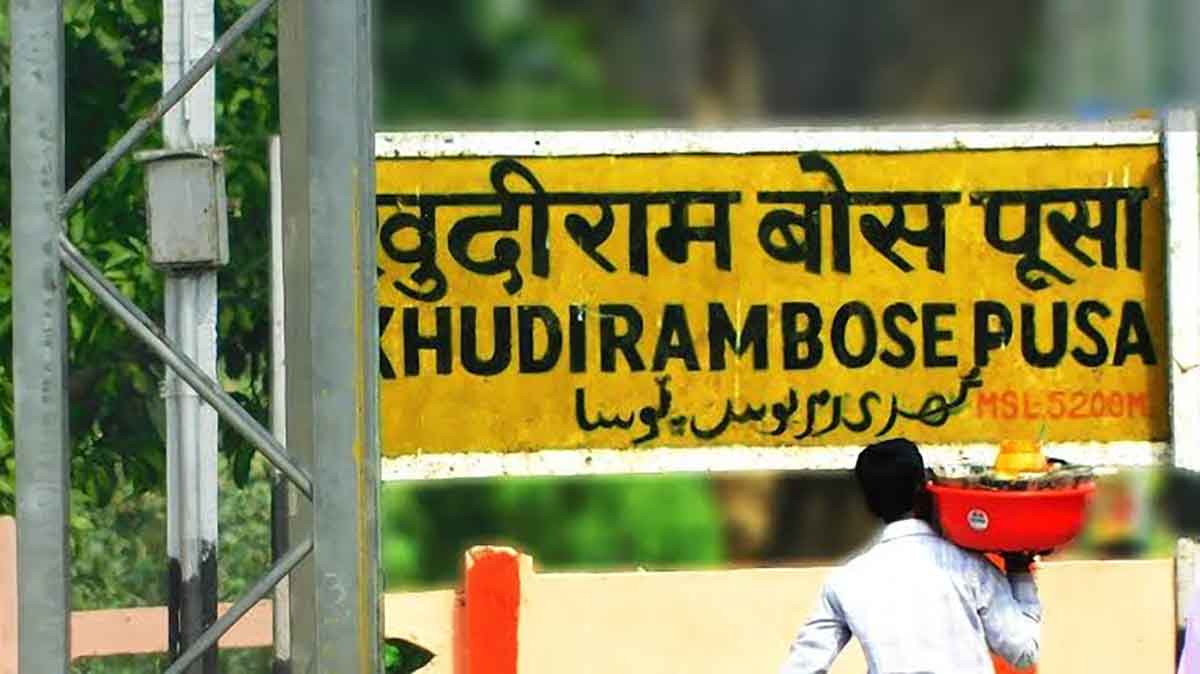 Waini railway station was renamed as Khudiram Bose Pusa Station. |
Khudiram - 18 years old smiling Martyr
Khudiram became proud as his leaders gave him this great responsibility. His face flushed with joy. When his friends saw that Khudiram bought a pair of new shoes, they were astonished because he didn’t wear shoes for a long back. They asked with eager faces – You have purchased new shoes!
– Yes, I am going to marry.
– Where?– In the North.
– When will you come back?
– Never! I’ll live in my father-in-law’s house permanently.
What a humuor! No anxiety, no restlessness, and no excitation was found in his behaviour.
Khudiram and Prafulla Chaki reached Muzaffarpur on 10th April 1908. But they found that Kingsford had restricted his movement after being alarmed by the intelligence. Khudiram and Prafulla Chaki took shelter in a lodge and were watching the movement of Kingsford. On 30th April, they got an opportunity. At about 8.30 they saw that Kingsford’s car had been returning from the nightclub. Khudiram threw the bomb, which exploded loudly. The car went afire. Thinking that the operation was successful, Khudiram and Prafulla escaped from the spot and decided to be parted and walk towards opposite directions along the railway track.
Khudiram reached Wyni rail station the next morning, which was 25 miles away from Muzaffarpur. Then he was extremely thirsty. When he was drinking water in a food stall, two constables arrested him.
After a body search the police got two revolvers, 37 round bullets, an Indian railway map, and a page of a railway timetable. Khudiram was chained and brought back to Muzaffarpur. But he was not afraid. He shouted "Bande Mataram", when he was brought by a police car. The Statesman wrote: “The railway station was crowded to see the boy. A mere boy of 18 or 19 years old, who looked quite determined. He came out of a first-class compartment and walked all the way to the phaeton, kept for him outside, like a cheerful boy who knows no anxiety … … on taking his seat the boy lustily cried ‘Bande Mataram’.”
Prafulla Chaki was also chased by the police. To avoid arrest, he committed suicide at Mokamaghat railway station on 1st May 1908. But till then Khudiram did not know this news, so he confessed everything and shouldered all responsibilities to save Prafulla. Later for identification, his dead body was brought to Muzaffarpur where Khudiram confirmed his identity.
His trial started on 21st May. When Khudiram came to know that the bomb killed two innocent English women Mrs. Kenedy and Miss. Kenedy and Kingsford escaped from the attack he was shocked. According to IPC 302, he was prosecuted for murder. On 13th June Judge Karndoff gave his verdict. Khudiram was sentenced to death.
When the verdict was given, Khudiram was smiling. The judge thought that he could not understand the verdict. So he asked Khudiram if he understand the significance of the verdict.
Khudiram – Of course.
Judge – Have you anything to say?
Khudiram – If you allow me, I can narrate the technique of making a bomb.
The Judge ordered the police to take him away.
A week was granted for an appeal to the High Court. But Khudiram did not want to appeal. He was ready to sacrifice his life. But in the direction of the party his advocates told him, that if his appeal was granted, he might get an opportunity to work for the country.
Then Khudiram agreed. But this appeal was rejected on 13th July at the Court of Mr. Brett and Mr. Ryves. The whole nation burst into a thunderous protest against this capital punishment. Rallies and agitations were organized in Calcutta and other parts of the country. But nothing could prevent the imperialists from executing the sentence. Though all these did not leave any impression on Khudiram. He was in total mental peace. His weight was increased.
This boldness, valiant sacrifice, and calmness became a symbol of revolt and youthfulness. It inspired the students and youths one after another generation. The life of Khudiram became a symbol of self-dignity, boldness, and deep love for the poor and destitute.
His sacrifice was not out of a momentary decision, but the culmination of his struggling life. He is a great martyr of the uncompromising trend of India’s freedom movement. Khudiram not only stirred the youths of pre-independent India but still inspires the young and struggling hearts.
In 1911, when Subhas Chandra Bose was a schoolboy, he observed martyr’s day by fasting. Similarly, the young martyr Madhai Halder, who laid down his life protesting against the anti-people policies of CPI(M)-government of West Bengal, observed his martyr’s day at his home. He used to tell his mother Gayeswari Devi, “I will be like Khudiram!”
Due to this the ruling capitalist class and their stooges are afraid of martyrs like Khudirm. That’s why they are trying to push these characters of the uncompromising trend of the freedom struggle into oblivion.
In independent India, these fighters and martyrs were labelled as ‘terrorists’. The uncompromising trend is not given importance in the history of the freedom movement.
The first Prime Minister of India, Mr. Jawaharlal Nehru, refused to unveil the statue of Khudiram as he did not represent the trend of the non-violence movement. In the syllabus of NCERT textbooks Khudiram, Bhagat Singh, and Asfaqullah have been described as terrorists.
But people fighting for the cause of emancipation, of real freedom, for them Khudiram’s life is an inexhaustible fountain of inspiration.
All India DSO observes the martyr’s day of this great revolutionary in a befitting manner. Comrade Shibdas Ghosh, the great Marxist thinker of this era, educated us, “If we don’t study and cult the characters of great men of past, we will be rootless.” All India DSO never forgets this education. What is more, the struggle of remembering a revolutionary character can never be academic; rather it is inseparable from the struggle to build up a new social system, which will be free from all sorts of exploitation.
References:
- Bhattacharya Sabyasachi & Panikar, K. N, towards freedom documents on the movement for independence in India, 1940.
- Choudhury Ramadevi "Jivan Pathe", Cuttack,
- Dyal Keshav, famous layers of freedom struggle and trials of freedom fighters, 1957.
- Shivasankar K., Khudiram Bose, 1949.
- Sarkar Sumit, The Swadeshi Movement in Bengal, 1903-1908, 1999.
- The Samaja.
- The Prajatantra.
 Support Us
Support Us
Satyagraha was born from the heart of our land, with an undying aim to unveil the true essence of Bharat. It seeks to illuminate the hidden tales of our valiant freedom fighters and the rich chronicles that haven't yet sung their complete melody in the mainstream.
While platforms like NDTV and 'The Wire' effortlessly garner funds under the banner of safeguarding democracy, we at Satyagraha walk a different path. Our strength and resonance come from you. In this journey to weave a stronger Bharat, every little contribution amplifies our voice. Let's come together, contribute as you can, and champion the true spirit of our nation.
 |  |  |
| ICICI Bank of Satyaagrah | Razorpay Bank of Satyaagrah | PayPal Bank of Satyaagrah - For International Payments |
If all above doesn't work, then try the LINK below:
Please share the article on other platforms
DISCLAIMER: The author is solely responsible for the views expressed in this article. The author carries the responsibility for citing and/or licensing of images utilized within the text. The website also frequently uses non-commercial images for representational purposes only in line with the article. We are not responsible for the authenticity of such images. If some images have a copyright issue, we request the person/entity to contact us at This email address is being protected from spambots. You need JavaScript enabled to view it. and we will take the necessary actions to resolve the issue.
Related Articles
- Kartar Singh Sarabha - The Freedom fighter who was Hanged at the age of 19 and inspired Bhagat Singh
- Father of the Nation! Absolutely not. Mohandas Karamchand Gandhi was not the father of the nation either officially or otherwise
- Vinayak Damodar Savarkar – A Misunderstood Legacy
- A Great man Beyond Criticism - Martyrdom of Shaheed Bhagat Singh (Some Hidden Facts)
- Our first true war of independence lie forgotten within the fog of time and tomes of propaganda: Sanyasi Rebellion, when "renouncers of the material world" lead peasants in revolt against British and fundamentalist islamic clans
- With Lord Mountbatten & Edwina's 'bed-hopping' marriage - gay brothels and affair with PM, British historian Andrew Lownie reveals it all
- Taimur was attacked and defeated by 20 year old Rampyari Gurjar and her army of 40,000 women
- If only India’s partition chilling wound was not enough, Gandhi did his last protest again only to blackmail India into giving 55 crores to Pakistan, dragged Hindu, Sikh refugees seeking shelter in mosques to die in cold: And we call him Mahatma, not for
- Tirot Singh: An Unsung Hero of the Khasi Tribe who destroyed British with his skill at Guerrilla Warfare
- Reality of Britishers who tortured, brutalized Indian women and threw them into sexual slavery
- Letter to Shaheed Sukhdev 5th April, 1929 - Collected work of Shaheed Bhagat Singh and his Co-patriots
- Harmonizing Nathuram Godse: Why India should move beyond denouncing him, a man who altered the course of not only the politics of the country but the very history of the Hindu Civilisation and, by extension, the world at large
- How Britishers were challenged by 83 year old Ropuiliani in Mizoram in 1892-’93
- Hero of Pawankhind: Veer Maratha Bajiprabhu Deshpande, who led 300 Soldiers against 12000 Adilshahi Army defending Shivaji
- Santi Ghosh and Suniti Choudhury: Two Teenage Freedom Fighters Assassinated British Magistrate














